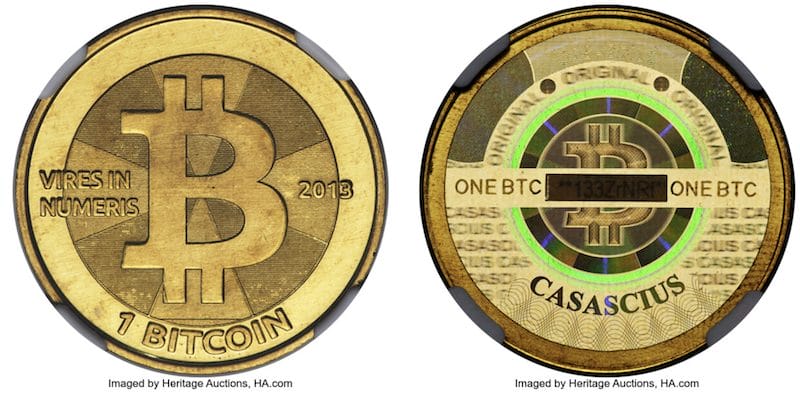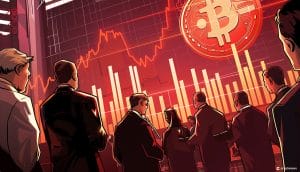Physical Bitcoin Worth Over $1 Million Presented At Auction Houses

Well-known auction houses that typically offer rare coins, famous artworks, and other popular assets for collectors to bid on have started capitalizing on physical Bitcoin (BTC).
Both Stack’s Bowers Galleries and Heritage Auctions are presenting “physical cryptocurrencies” as part of their upcoming showcases, highlighting collector interest in tangible coins representing popular digital assets.
James McCartney, Director of Consignments and Numismatics at Stack’s Bowers Galleries, told Cryptonews that the gallery recently announced its “Bitcoin Halving Sale,” which will be featured as part of their Spring 2024 Showcase Auction.
McCartney shared that the Bitcoin Halving Sale will consist of more than 200 physical cryptocurrency coins with a combined market value of more than $1 million (all values based on $60,000 BTC value).
“This is the firm’s first physical crypto sale of the year and certainly one of the most significant they have put together since entering the category in 2021,” said McCartney. “It is also the very last dedicated crypto auction to be held before the Bitcoin Halving event predicted for mid-April, which has been subject to tremendous excitement and speculation.”
The Concept Behind Physical Bitcoin
According to McCartney, physical Bitcoins are essentially cold wallets that resemble specific cryptocurrencies. He added that some of these physical collectables can contain a public address that is unique to each coin, which may be loaded with cryptocurrency at the time of sale.
“This format was made popular by the Casascius and Lealana series produced from 2011 through 2013, but many more producers have since made coins of their own,” he said.
For context, Bitcoinwiki.org notes that “Casascius Physical Bitcoins” – also known as Casascius coins – are physical metal coins that were created by a Bitcoin user by the name of “Casascius.”
Have you ever given #Bitcoin to people as a gift and the the price skyrockets?
My guest Mike Caldwell, the creator of Casascius Physical Bitcoins, used to give these out as Christmas gifts in 2011 until the Gov't shut him down.
Listen to his story at https://t.co/OPfZCStjSx pic.twitter.com/tM9xH0WoGN
— Charlie Shrem (@CharlieShrem) July 9, 2019
These coins with actual Bitcoin embedded in them were sold from 2011 until Nov. 2013. Yet sources note that Casascius collection’s creator, Mike Caldwell, received a cease and desist letter from the U.S. Government, putting an end to the series entirely in 2013.

Physical Cryptocurrency Viewed as Rare Collectables
Sam Spiegel, Director of International Numismatics at Heritage Auctions – a Dallas, Texas-based auction house founded in 1976 – told Cryptonews that physical cryptocurrency from the Casascius collection has since become rare, piquing the interest of coin collectors and crypto enthusiasts alike.
“Heritage offered its first piece of physical cryptocurrency last year. We began in earnest with our offering of Part 1 of the ‘Otoh Collection,’ which was sold last November,” said Spiegel. “This was a major private collection from an early adopter; believe it or not, these were bought by the Otoh collector directly from Casascius (who produced these) in 2013 for a small fraction of what they are worth today.”
Following this auction, Spiegel noted that physical crypto assets have made a “big splash” within Heritage Auctions’ collecting community.
“More of these physical cryptocurrency coins have been coming in from other collectors for our auctions,” he said.
Given this rising interest, McCartney pointed out that Stack’s Bowers’ long-time collectors have started to pay attention to physical cryptocurrency collections after focusing on traditional rare coins for years or decades.
“We view physical bitcoins on par with traditional numismatic categories like $20 gold coins or Morgan silver dollars that have been prized by collectors for decades,” McCartney said. “Since first entering the category in 2021, we’ve sold over 1,000 physical crypto coins and achieved more than $4.5 million in total prices.”
Spiegel further noted that Heritage Auctions has seen a mix of collectors taking interest in its physical crypto collections.
“Some are very traditional coin collectors who are buying these as a piece of numismatic history, though we’ve also seen crypto and NFT enthusiasts buy these as historical Web3 items,” he added.
Physical Bitcoin Selling for More Than BTC Market Value
While the concept of physical cryptocurrency may appeal to a specific group of collectors, it’s interesting to note that some of these collections are selling at higher prices than a cryptocurrency’s market value.
According to Spiegel, the value of a physical cryptocurrency is often determined by the market, yet collectors will typically bid these items up. He added that Heritage Auctions will start each lot – meaning an individual object or group of objects offered for sale at auction as a single unit – with no minimum bid, and offer them without reserve.
“In the case of lot #65215, it sold for $78,000, when at the time bitcoin was about $63,500,” said Spiegel. “This is because collectors placed a premium on these collectible items. In my mind, it’s not dissimilar to collectors paying a premium over the gold price for a rare, collectible gold coin.”

Matthew Weller, Global Head of Research at StoneX – an institutional-grade financial services franchise – told Cryptonews that given the positive correlation between Gold and Bitcoin, it might make sense for some investors to pay a small premium for a physical cryptocurrency.
“This is the case especially if the investor values the artistic value, security features, or if the physical coin offers additional functionality, such as a hardware wallet,” said Weller. “Physical coins can also be crafted with intricate designs and made from precious metals, making them collectible items. For enthusiasts and collectors, this adds an aesthetic value beyond the 1s and 0s that make up the digital currency itself.”
Indeed, McCartney explained that these coins are typically comprised of struck metal – commonly brass or silver – and conceal a private key beneath a tamper-resistant holographic sticker.
“Oftentimes, the first digits of the public address are engraved or printed on the security sticker so that the funded status or amount can be verified,” he explained.
In order for a collector to “redeem” the coin, McCartney noted that the holographic sticker must be peeled to reveal the private key, which allows the owner to sign a transaction, thus “spending” the associated Bitcoin.
McCartney added that once a physical crypto coin has been redeemed it can’t be re-loaded.
“They are considered spent,” he said.
Unsurprisingly, McCartney explained that as more physical Bitcoins continue to be redeemed, the rarity and desirability of those intact “unspent” coins increases.
“This explains the appeal of physical Bitcoins from a collectible standpoint and why we have seen them command sizable premiums compared to their ‘face value,” McCartney pointed out.
For example, McCartney noted that there were originally around 28,000 coins “loaded” as part of the Casascius series. Yet only around 18,000 remain intact.
“More continue to be redeemed as time goes on,” he said.
Tangible Crypto Drives Mainstream Interest
Although physical cryptocurrency may appeal primarily to collectors, these tangible assets could help drive mainstream adoption if the concept catches on.
For instance, Spiegel mentioned that he believes these coins are broadening the appeal of cryptocurrency.
“The more we offer these items at auction, the more legitimacy they have as collectibles, as evidenced by the fact that the premiums have been quite strong,” he remarked.
Weller added that there are likely investor-minded individuals who want to have some portion of cryptocurrency in their portfolios, yet may be more comfortable having something tangible.
“Stack’s Bowers Galleries sales should certainly help create a familiarity with Bitcoin for those who are curious or collector-minded,” said McCartney. “Collectible physical Bitcoin is still a niche category within the overall cryptocurrency community, but we are optimistic for wider adoption as we continue to invest and spread awareness about the category.”




